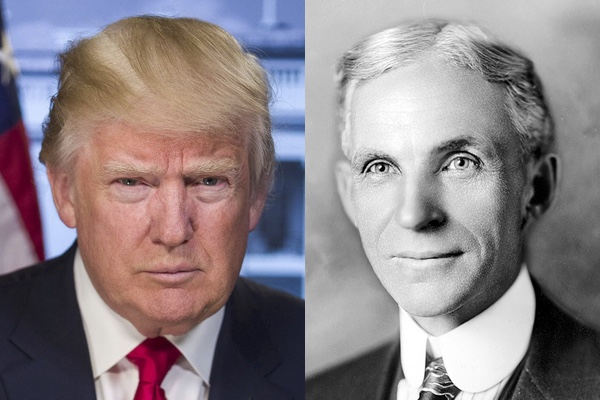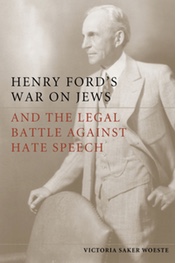When Trump Denounces the “Fake Media” Anti-Semites Hear “Jew Media”

His attacks resemble Henry Ford’s. He too was embraced by anti-Semites.
On August 14, President Trump reluctantly read a statement intended to assure Americans that, contrary to an impression left by his earlier speech, he condemned the neo-Nazis and white supremacists who marched in Charlottesville. The next day, he returned to Twitter to complain about the press: “Made additional remarks on Charlottesville and realize once again that the #Fake News Media will never be satisfied …. truly bad people!”
 Trump has been
picking fights with the media since he declared his candidacy. But
these latest outbursts reveal more than ordinary presidential
frustration with the press. And they’re no ordinary way of
expressing that frustration. Trump has long played on racism against
African-Americans to attract white supremacists. He does the same
when he demonizes the media.
Trump has been
picking fights with the media since he declared his candidacy. But
these latest outbursts reveal more than ordinary presidential
frustration with the press. And they’re no ordinary way of
expressing that frustration. Trump has long played on racism against
African-Americans to attract white supremacists. He does the same
when he demonizes the media.
The president is deploying, consciously or not, a classic trope from the Russian anti-Semitic fabrication, The Protocols of the Elders of Zion, published in 1905. When he says “fake media,” anti-Semites hear “Jewish-controlled media,” which exerts disproportionate power over other media outlets and public opinion. Anti-Semites understand what Trump is doing. They blame the “whining Jew media” for forcing Trump to condemn the Nazis who marched in Virginia.
The Protocols are the Bible of the anti-Semitic movement. They purport to be the minutes of a meeting where Jewish elders detail their plan to conquer the world. In the part of the Protocols titled “Control of the Press,” it is “revealed” that Jews control every aspect of the press to protect their new worldwide government from attack or criticism. The unnamed narrators admit their real aim is a false-flag attack on the legitimate press: “Among those making attacks on us will also be organs established by us, but they will attack exclusively points that we have pre-determined to alter.” Fake news, then, begins as Jewish infiltration of the legitimate press and transforms into complete domination: “Not a single announcement will reach the public without our control.”
The first American to put the Protocols before a mass audience was Henry Ford. In the 1920s his newspaper, the Dearborn Independent, alleged that American Jews worked to advance the interests of an amorphous “International Jew.” As the Protocols presaged, Ford lumped all Jews into an anonymous cabal who aimed to seize control of world banks, industry, and government. Of all the distinguished Jewish Americans whom Ford libeled, it was a relatively obscure lawyer, Aaron Sapiro, who finally sued. When Sapiro’s case came to trial in 1927, Ford decided to issue an apology in order to avoid a damaging jury verdict. He said, “I deem it to be my duty as an honorable man to make amends for the wrong done to the Jews as fellow-men and brothers, by asking their forgiveness for the harm I have unintentionally committed.”
But many skeptics refused to believe Ford meant it. In Europe, anti-Semites contended that “Jewish bankers forced the apology” out of Ford. Publishers who wanted to reprint Ford’s anti-Semitic publications insisted that the statement had been faked to assuage the “International Jew.” Having followed the Sapiro trial through a German reporter he planted in the courtroom, Adolf Hitler called the apology “Ford’s subjugation to the All-Jewish High Finance.” In time, Ford eliminated all doubt. In 1938, he accepted the highest civilian honor Hitler’s government could bestow. Photographs of a smiling Ford wearing the Grand Cross of the German Eagle splashed across the world. The automaker could not have repudiated his own apology more effectively. Accepting the medal made it clear he had not “capitulated to the core of the Jewish danger.”
Thus the language and tactics that Trump uses today have already been validated by one of America’s foremost proponents of anti-Semitism. The president declares that the mainstream media “filter” must be eluded. Ford did this by buying his own newspaper, while Trump does it with Twitter. The result is the same. In 2016, Trump signaled his neo-Nazi/radical right sympathies by initially refusing to reject David Duke’s endorsement. Recently, Trump waffled when pressed to condemn those who declare “Jews will not replace” them. What links Trump and Ford most strongly are their anti-Semitic methods. Both refract their beliefs through relentless attacks on the very media that they use to advance their businesses and polish their images.
Trump’s collusions with white supremacists, his declaration that “many sides” are morally responsible for Charlottesville, and his defenses of the “fine people” carrying swastikas and torches are shocking. But they are also eerily reminiscent of Ford’s genteel anti-Semitism, which flourished when most everyone knew who was behind the “fake media” and believed instead the businessman in charge.